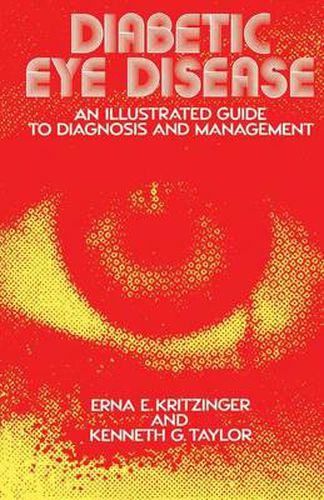Readings Newsletter
Become a Readings Member to make your shopping experience even easier.
Sign in or sign up for free!
You’re not far away from qualifying for FREE standard shipping within Australia
You’ve qualified for FREE standard shipping within Australia
The cart is loading…






This title is printed to order. This book may have been self-published. If so, we cannot guarantee the quality of the content. In the main most books will have gone through the editing process however some may not. We therefore suggest that you be aware of this before ordering this book. If in doubt check either the author or publisher’s details as we are unable to accept any returns unless they are faulty. Please contact us if you have any questions.
The commonest cause of blindness in young and middle-aged people in the Western world is diabetes mellitus. Although the mechanism underlying diabetic retinopathy is still not understood, the technology to reduce its progress exists, provided treatment is given at the appropriate time. Doctors caring for patients with diabetes should be familiar with all aspects of diabetic retinopathy as well as the other ocular complications of diabetes. They also need a basic knowledge of the special techniques used in the diagnosis and treatment of diabetic eye disease (fundus fluorescein angiography, retinal photocoagulation, vitrectomy) and to understand how these procedures affect the diabetic patient in terms of limitation of activities and time off work. To ensure the most efficient use of ophthalmic services a clear plan of referral to ophthalmologists is required. These are the concepts on which this guide is based, compiled by an ophthalmologist involved in the treatment of diabetic eye disease and a physician with a special interest in diabetes. In addition to doctors involved in the management of diabetic patients, this guide may be of value to ophthalmic opticians, medical students and nurses as a self-instruction manual. ‘ 7 1 Examination of the Eye Testing visual acuity Using the ophthalmoscope The normal fundus The abnormal fundus Recording the findings 9 TESTING VISUAL ACUITY Method Test one eye at a time. Test distant visual acuity. Correct the refractive error if the visual acuity is worse than 6/6.
$9.00 standard shipping within Australia
FREE standard shipping within Australia for orders over $100.00
Express & International shipping calculated at checkout
This title is printed to order. This book may have been self-published. If so, we cannot guarantee the quality of the content. In the main most books will have gone through the editing process however some may not. We therefore suggest that you be aware of this before ordering this book. If in doubt check either the author or publisher’s details as we are unable to accept any returns unless they are faulty. Please contact us if you have any questions.
The commonest cause of blindness in young and middle-aged people in the Western world is diabetes mellitus. Although the mechanism underlying diabetic retinopathy is still not understood, the technology to reduce its progress exists, provided treatment is given at the appropriate time. Doctors caring for patients with diabetes should be familiar with all aspects of diabetic retinopathy as well as the other ocular complications of diabetes. They also need a basic knowledge of the special techniques used in the diagnosis and treatment of diabetic eye disease (fundus fluorescein angiography, retinal photocoagulation, vitrectomy) and to understand how these procedures affect the diabetic patient in terms of limitation of activities and time off work. To ensure the most efficient use of ophthalmic services a clear plan of referral to ophthalmologists is required. These are the concepts on which this guide is based, compiled by an ophthalmologist involved in the treatment of diabetic eye disease and a physician with a special interest in diabetes. In addition to doctors involved in the management of diabetic patients, this guide may be of value to ophthalmic opticians, medical students and nurses as a self-instruction manual. ‘ 7 1 Examination of the Eye Testing visual acuity Using the ophthalmoscope The normal fundus The abnormal fundus Recording the findings 9 TESTING VISUAL ACUITY Method Test one eye at a time. Test distant visual acuity. Correct the refractive error if the visual acuity is worse than 6/6.